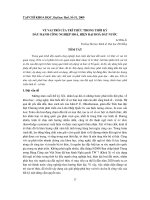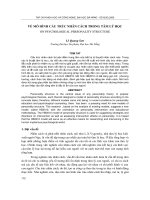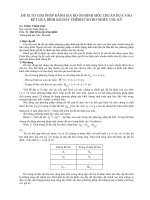Báo cáo nghiên cứu khoa học: "Về một điều kiện đủ cho tính ổn định mũ của một lớp phương trình vi phân ngẫu nhiên có trễ" pot
Bạn đang xem bản rút gọn của tài liệu. Xem và tải ngay bản đầy đủ của tài liệu tại đây (183.86 KB, 4 trang )
dx(t) = f(x(t), x(t − τ), t)dt + σ(t, x(t))dw(t).
dx(t) = f(x(t), x(t − τ), t)dt.
dx(t) = f(x(t), x(t−τ), t)dt+σ(t)dw(t). (1.1)
dx(t) = f(x(t), x(t−τ), t)dt+σ(t, x(t))dw(t). (1.2)
(Ω, , {
t
}
t0
, P )
{
t
}
t0
|x| x ∈ R
n
A
A = sup{|Ax| : |x| = 1} B
T
1
A = (a
ij
) Trace(A) =
a
ii
τ
C([−τ, 0]; R
d
) R
d
−
[−τ, 0] L
2
t
([−τ, 0]; R
d
)
t
− C([−τ, 0]; R
d
)
ξ = {ξ(u) : −τ u 0}
ξ
2
E
= sup
−τ u0
E|ξ(u)|
2
< ∞.
dx(t) = f(x(t), x(t−τ), t)dt+σ(t, x(t))dw(t); on t ≥ 0 (2.1)
x(t) = ξ(u) −τ u 0 f : R
d
× R
d
× R
+
→ R
d
,
σ : R
d
×R
+
→ R
d×m
w ξ ∈ L
2
0
([−τ, 0]; R
d
)
x(t, ξ)
(2.1)
δ K
ξ ∈ L
2
0
([−τ, 0]; R
d
)
E|x(t, ξ)| Kξ
2
E
e
−δt
, ∀t ≥ 0. (2.2)
δ K
u(t) v(t)
N
0
t ≥ s
u(t) N
0
+
t
s
u(t
1
)v(t
1
)dt
1
.
t ≥ s
u(t) N
0
exp{
t
s
v(t
1
)dt
1
}. (2.3)
c
1
− c
3
2x
T
f(x, y, t) −c
1
|x|
2
+ c
2
|y|
2
,
T race(σ(t, x)σ
T
(t, x)) c
3
|x|
2
,
c
2
e
c
1
τ
+ c
3
< c
1
,
x, y ∈ R
d
; t 0. (2.1)
Proof. For all ξ ∈ L
2
F
0
([−τ, 0]; R
d
) Fix ξ arbitrarily and write x(t, ξ) = x(t) simple. By Ito’s
formula and assumption,
e
c
1
t
|x(t)|
2
= |x(0)|
2
+ M(t) + N(t)
for all t ≥ 0, where
M(t) = 2
t
0
e
c
1
s
x
T
(s)σ(s, x(s))dw(s).
N(t) =
t
0
e
c
1
s
(c
1
|x(s)|
2
+ 2x(s)
T
f(x(s), x(s − τ), s) + trace(σ(s, x(s))σ
T
(s, x(s)))ds.
By (i), (ii) we have
e
c
1
t
|x(t)|
2
|x(0)|
2
+M(t)+
t
0
e
c
1
s
(c
2
|x(s−τ)|
2
+c
3
|x(s)|
2
)ds. (4.4)
But
t
0
e
c
1
s
|x(s − τ)|
2
ds
τ
0
e
c
1
s
|x(s − τ)|
2
ds +
max {τ,t}
τ
e
c
1
s
|x(s − τ)|
2
ds
τ
0
e
c
1
s
|x(s−τ)|
2
ds+e
c
1
τ
t
0
e
c
1
s
|x(s)|
2
ds. (4.5).
From inequalities (4.5) and (4.4) follow that
e
c
1
t
|x(t)|
2
|x(0)|
2
+ M(t) +
τ
0
e
c
1
s
c
2
|x(s − τ)|
2
ds +
t
0
(c
3
+ c
2
e
c
1
τ
)e
c
1
s
|x(s)|
2
ds
because EM(t) = 0, moreover we have
τ
0
e
c
1
s
c
2
E|x(s − τ )|
2
ds
c
2
c
1
(e
c
1
τ
− 1)ξ
2
E
; E|x(0)|
2
ξ
2
E
so that
e
c
1
t
E|x(t)|
2
E|x(0)|
2
+
τ
0
e
c
1
s
c
2
E|x(s − τ )|
2
ds +
t
0
(c
3
+ c
2
e
c
1
τ
)e
c
1
s
E|x(s)|
2
ds
(1+
c
2
c
1
(e
c
1
τ
−1))ξ
2
E
+
t
0
(c
3
+c
2
e
c
1
τ
)e
c
1
s
E|x(s)|
2
ds. (4.6).
From (4.6) and applying lemma 2.2 with
u(t) = e
c
1
t
E|x(t)|
2
; v(t) = c
3
+ c
2
e
c
1
τ
; N
0
= (1 +
c
2
c
1
(e
c
1
τ
− 1))ξ
2
E
we have
e
c
1
t
E|x(t)|
2
(1 +
c
2
c
1
(e
c
1
τ
− 1))ξ
2
E
e
(c
3
+c
2
e
c
1
τ
)t
.
Hence we obtain
E|x(t)|
2
(1 +
c
2
c
1
(e
c
1
τ
− 1))ξ
2
E
e
(c
3
+c
2
e
c
1
τ
−c
1
)t
By assumptions (iii) we can rewrite
E|x(t)|
2
Kξ
2
E
e
−δt
,
where K = 1 +
c
2
c
1
(e
c
1
τ
− 1) > 0 and δ = c
1
− c
3
− c
2
e
c
1
τ
> 0.
In other words,the stochastic differential equations (2.1) is e xponential stability in mean
square. The proof is completed.
Acknowledgement.
dx(t) = f(x(t), x(t − τ), t)dt + σ(t, x(t))dw(t).
dx(t) = f(x(t), x(t − τ), t)dt.









